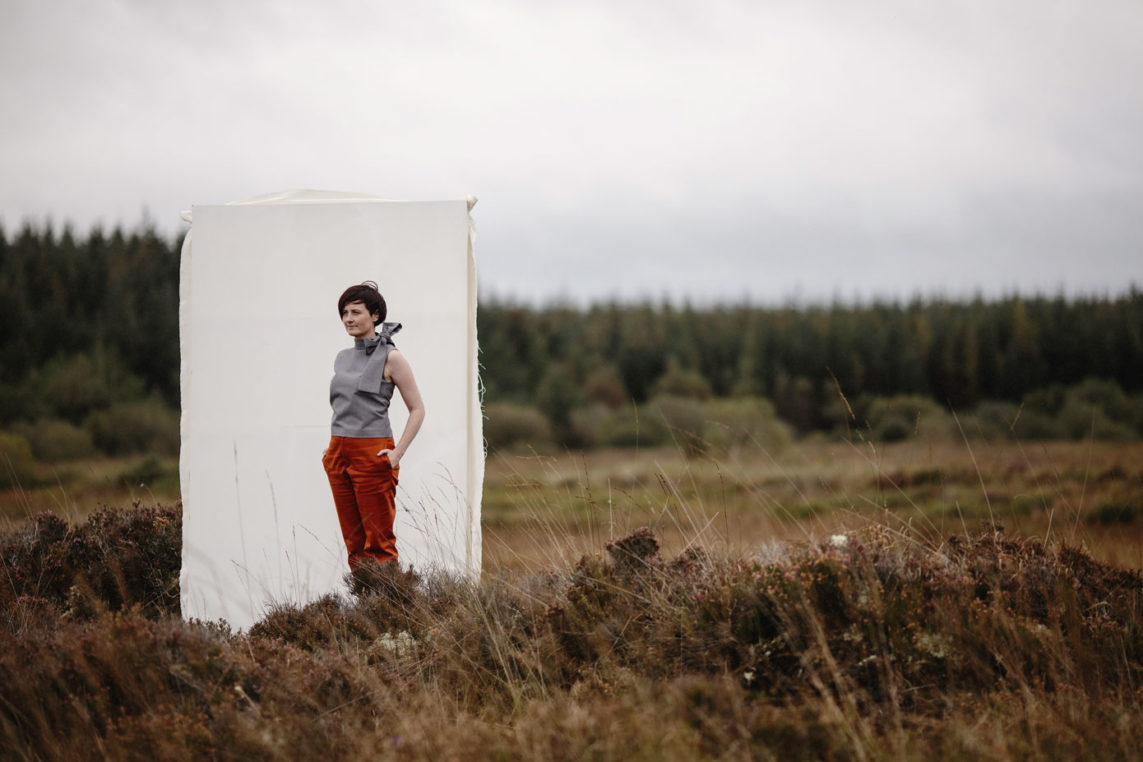Acclaimed Irish visual artist Tracy Sweeney’s latest exhibition “Fighting with Shadows” is currently touring the US, inspired by emigration during the Great Famine. It’s emotionally charged, with themes such as the “loss of home” and the “land beneath our feet.”
In this exclusive interview, Tracy Sweeney talks about her creative process and unique technique.

How do you define your artistic style?
I would say it is experimental mixed-media. With this style of painting, spontaneity is key, the “happy accident” is hugely important. I find pleasure in the experimental nature of mixed media combinations and thrive on unfamiliarity when painting. My starting point is a body of photographs I’ve captured; rusted boats, layers of paint that have peeled over time; industry and graffiti; or the layers of history revealed through the exterior of an old ruin.

How do you paint?
The photograph serves as the starting point, usually a colour, or the initial question of how a surface has formed either manually or organically. I abandon paintbrushes and paint with trowels, scrapers and chisels, effectively builders’ tools. The work is highly physical, ripping into surfaces, pulling back, re-plastering. I liken it to building a wall and then tearing it down to become an artefact, evoking the sense of an object through colour, texture and contrasts; or directly reflecting a glimpse of reality by recreating it on the picture plane.

How has your artistic journey evolved?
Interestingly, I studied printmaking for my BA in GMIT. The rules and parameters of the print process appealed to me, the physicality of working into copper plates and dipping them in acid, the alchemy, the transformation and the science behind the whole process. I was enamoured and exhibited prints widely for years. I had and still have a very experimental printmaking practice, it broke all the usual traditions. I was mentored by the artist John-Noel Smith. He impressed on me the importance of transferring my atypical printing skills into paint eg using all my printmaking tools to paint, instead of using a paintbrush.

What or who was influential in terms of your decision to become an artist?
I am from Louisburgh, Co Mayo, rural west of Ireland. My grandmother taught me how to draw and my uncle was a photo-realist painter. As a child I was mesmerised by his work. My main memory was the smell of the oils and turpentine he used. He painted in an ancient shed, full of tools and tea chests but his works were linear, architectural and red; lots of red paint. When I paint, I like to think I’m creating paintings that make the viewer hark back to another world, the memory of a smell, a texture, or the ‘reality’ of surface or place. The idea of recreating either memories or observations is a set of dualisms that can be seen to pervade my work. I can move between abstract and figurative, colour and monotone, memory and reality; whatever feels right as I go.
You’ve won many awards – which has helped most with national and international exposure?
My Pollock Krasner Award from the US was a huge achievement. Financially it gave me the independence to allow me to develop a collection for an exhibition after having my first baby in Stockholm and then returning to Ireland. Sales aside, it was the mental boost I needed; the belief that an international arts organisation believes in you, only serves to heighten your confidence as an artist and allows you to continue developing your practice.

Tell us about the latest collection and the exhibition you have been preparing for?
In November 2018, an acquaintance, Kevin Mulvey contacted me from San Francisco. His family emigrated from our townland, Straide, near Foxford in Co Mayo in the 1920s to Hamden, Connecticut. The ruins of their ancestral cottage stand near to my studio. He commissioned a painting to donate to Ireland’s Great Hunger Museum at Quinnipiac University in Connecticut, where a stunning collection of Irish art is housed, solely dedicated to emigration and the Great Famine.
It was a shift in subject matter for me from my usual work, but the wealth of emotion about emigration runs so deep in our locale that it’s a topic I have been approached about by a number of interested parties for commissions and future exhibitions. The initial project has now expanded to a collection of my work for the exhibition at the museum. When it finishes its term in February 2020, I will then tour the work in other US cities. I have titled the collection “Fighting with Shadows”. It’s emotionally charged, raw and I believe appeals on a universal and genetic level: the “loss of home” or “the land beneath our feet” and having to leave it and our ownership of that.

Your studio couldn’t be more rural – what do you like most about it?
I am productive and disciplined in my own company, the quietness feeds into that. By comparison, having worked in busy city studios I do miss the immediate critical feedback. On the other hand, social media allows a continuous conversation with the outside world, being able to show a live feed of my process, paint application which helps engage with an audience and also allows for feedback. You need a conversation about the works to generate new ideas.
To see more from Tracy Sweeney visit www.tracysweeney.com
Photographs by Al Higgins
See more from the Artistic License series






